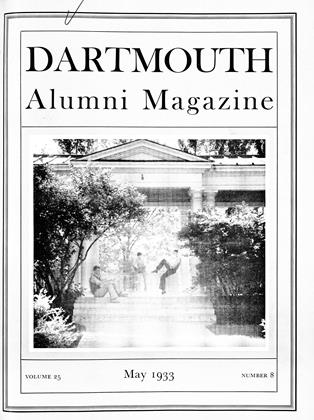To ALL EXCEPT those most concerned with administrative affairs in Hanover the statistics re- vealed by Councilor Whelden in his article in this issue will be little short of amazing. Dartmouth's growth as a national college has been recognized since the Selective Process of Admission was inaugurated in 1922. Alumni have understood that the preferential treatment given applicants living at a distance from Hanover was bringing the desired result—that of drawing upon every state in the Union for the enrollment of the undergraduate body of the College. But here, in the proof that accompanies carefully compiled facts and figures, is a ranking of 24 leading men's colleges as to students enrolled from the Central States district, with Dartmouth at the head of the list.
Illinois leads as the Dartmouth stronghold in the Middle West, this state being considerably outdistanced in representation in Hanover only by New York with 540 students, Massachusetts with 502, and New Jersey with 219. Ohio's delegation of 122 practically equals the enrollment of New Hampshire boys, 126. About the same number of students come from California (21) as from Maine (24). That these figures are a far cry from the situation of a hundred years ago is well enough known: in 1830 a total of 84% of the College came from New Hampshire and Vermont. And as recently as 30 years ago, during Dr. Tucker's campaign for more widespread distribution, 32% of the College hailed from these two home states.
To the Alumni Council might well be given the task of facing the problem of decreased enrollment of students from New Hampshire and Vermont. There has been a steady shrinkage in these delegations during recent years until now the combined figure represents only 7% of the undergraduate body. Financial difficulties probably explain why fewer applications are received from Dartmouth's immediate neighbors. For it is a problem of attracting and interesting New Hampshire and Vermont boys in Dartmouth, rather than a question of such applicants securing admission, since a decided preference is given to applications coming from these states.
The achievement of the Administration in extending Dartmouth's areas of influence to almost every corner of the country in its quest, for the College, of a national standing, is most gratifying. Mr. Whelden's definition of Dartmouth strength in the Central States is interesting evidence of the distinctive success of this policy of broadening the geographical distribution of students and making Dartmouth a truly representative American college.
 View Full Issue
View Full Issue
More From This Issue
-
 Article
ArticleHANOVER BROWSING
May 1933 By Rees Higgs Bowen -
 Class Notes
Class NotesClass of 1910
May 1933 By Harold P. Hinman -
 Class Notes
Class NotesClass of 1929
May 1933 By Frederick William Andres -
 Class Notes
Class NotesClass of 1902
May 1933 By Hermon W. Farwell -
 Article
ArticleDARTMOUTH'S WATCH ON THE RHINE
May 1933 By Gail M. Raphael '34 -
 Class Notes
Class NotesClass of 1932
May 1933 By Charles H. Owsley
Article
-
 Article
ArticleMR. TUCK GIVES BUILDING TO HISTORICAL SOCIETY
January, 1912 -
 Article
ArticleLARGE GATHERING CELEBRATES DARTMOUTH NIGHT OCT. 13
November, 1922 -
 Article
ArticleChart Number III. Consolidated Records against Teams Met More Than Twice
February 1934 -
 Article
ArticleNamed Football Aide
May 1954 -
 Article
Article$50,000 for Med School
January 1962 -
 Article
ArticleGym Talk: The Athletic Council
February 1934 By C. E. W.


